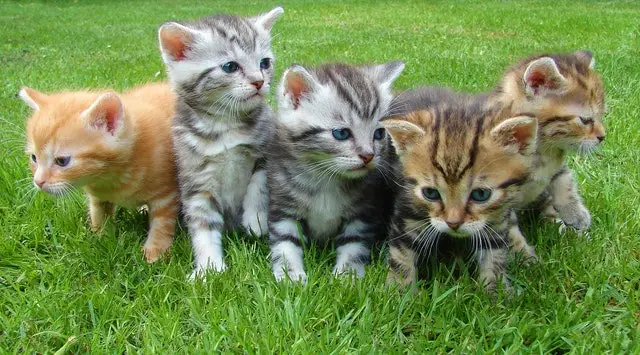
Sometimes our cat becomes bossy and aggressive: a real bully. But where does this behavior come from, and how to solve this problem?
In each group of cats there is a very specific hierarchy. Anyone who does not have more than one cat may not realize it. In feline “families” there is a role for each cat and a specific place. But when a cat becomes very bossy towards other cats, a dog, or even a human, there is a behavioral problem. A bully cat means having a cat who behaves without rules, for one reason or another. And this problem must be solved immediately and with care. Of course, first you need to understand the reason behind these issues, and then proceed accordingly.
The bully cat: where does it originate?
One of the most frequent cases of bullying in cats occurs when a second feline is added to a house where there is a kitten. If another animal is placed in a family, especially if another cat, the order and hierarchy that were already present are revolutionized, and a certain chaos ensues.
And just in such situations, one of the cats becomes a real bully, while the other becomes his favorite target for bullying and aggression. The most common scenarios that see a cat behave this way are as follows:
- A newly arrived cat attacking another kitten.
- Various cats bullying a single cat in the house.
- An outdoor cat (or even a stray) who subdues a house cat.
- A dog (even a puppy) bullying a cat.
- An adult cat that subdues a kitten (puppy).
- A kitten who subdues an adult kitten.
Let’s consider how to help both the victim and support the bully and redirect his aggression to solve the problem altogether. Let’s see how to proceed in the best way, depending on the case.
Eliminate problems between two cats
In the coexistence between two cats, there can be even bizarre behaviors that are actually normal in outline. But there may be cases in which action must be taken. Let’s take the case of a new cat arriving home, where another cat has been living for some time.
The cat already stabilized at home will probably welcome the newcomer with hissing and threatening sounds that are not soothing. Why isn’t she hospitable to another cat? Because he feels that a possible competitor is coming in terms of food, litter and territory.
So, the best thing to do in these cases is to start off on the right foot. Introducing a new kitten into the house is a stressful time for the cat who already lives with us, and we need to minimize that stress in some way. That way he won’t feel in any danger from the competition, and he won’t need to bully the newcomer.
Reduce Stress: Food
To reduce stress in the cat food factor, a great way is to offer them individual bowls. Having food resources always available seems obvious if we look at cats as pets, but remember that they are still linked to wild ancestors.
In nature, finding food is one of the most important (and often difficult) things. Sure, we offer our cats food and water without limits, but for them there is always a bit of territorial instinct that is ready to assert itself. If they were free, on the other hand, defending their food resources could be a matter of life or death.
As the cats (both the old inhabitants and the newcomer) become familiar and accustomed to the new condition, we may also use a shared food bowl. But until then – and even after that, until the hierarchy has stabilized – it’s best to keep separate bowls of food. It would also be better to keep the bowls in different areas of the house, and also to feed the cats at different times, so that they eat separately.
Reduce stress: the litter box
As with the food bowl, the litter box is also something very personal to a cat. Having enough litter boxes for everyone is important in this initial moment of new coexistence. When a cat does his business, he feels more vulnerable. This is so true that in case the cat has the feeling of not being safe, he prefers to give up using the litter box and do his business elsewhere.
We try to have a cat litter box, plus an extra one. There is always a need for a moment of intimacy for each of our cats, and it is important to never let them find the “bathroom” busy. We scatter the litter boxes in various parts of the house as much as possible.
In the case of a covered litter box, when a cat is bullied it is best to remove the lid or otherwise not to use a covered litter box. The cat will feel more comfortable if he can control what is happening around him, and thus prevent possible attacks. And of course, all litter boxes need to be kept clean on a daily basis.
Reduce stress: the territory
To reduce the stress related to the territory, you need to introduce the new cat into the house slowly. When bringing it home for the first time, we should keep it in a separate room from the other pets in the house (especially cats). If possible, it would be ideal to have them interact however a little through the space under the door of the room. Maybe they will start hissing, sticking their paws into space if large enough, and even a little wrestling. But let them do it.
When bringing the cat indoors, we use a cat carrier. This can be a means of allowing other pets to interact with the newcomer, smell him and – if really necessary – even blow against him / her. It will be a way to get to know him, even if apparently negative.
At all times, however, we must always be present and supervise the newcomer and – above all – the previous tenants. We let the new kitty go out for a while (short periods at a time) and visit his new home about him. At any time, however, we must be ready to take him and bring him back to his room, if we notice a situation that is too stressful for the various cats.
As anticipated, some behaviors are normal: hissing, arching the back, even hitting with the legs are totally acceptable in this situation. Cats need to establish a new pecking order and it won’t be a short step. Sometimes it takes a long time, even months (it could take up to a year in the case of older cats). It is essential to have a lot of patience.
Prevent cats from fighting

Let’s see now how to stop a cat’s aggression and also prevent it. Under no circumstances should we physically intervene to quell a fight between cats (nor between other pets), because it is not safe for our safety.
Here are some rules to follow in all these cases:
- No Physical Punishments: As mentioned, never get physically involved. Attacks from a cat, with scratches and bites, can also be serious and dangerous. Furthermore, physical punishment damages our relationship with the cat who will be afraid and could redirect this fear towards us.
- Verbal reprimands: use your voice, firm and rigid, telling the bully cat “no”, to make him understand which behaviors are correct and which absolutely cannot be accepted.
- Distractions: if two cats are struggling, a good way to divide them is to scare them, with a loud noise (a whistle) or an object falling in order to frighten them, without hurting them (a towel, a broom, etc.).
- Spray water: A simple bottle of water with a sprayer (such as those for watering plants) can become an excellent weapon for dividing cats and to reduce the aggressive behavior of the bully cat. We spray the cat with water, but only when it shows negative behavior, combining it with a “no” in a firm and decisive voice, as already mentioned.
- Safe spaces: we create a kind of refuge for the submissive cat, so that in case of need it can go to a place where the aggressive cat cannot access.
- Behavior modification: Sure, cat training isn’t as simple as dog training, but some negative cat behaviors can definitely be changed. We use food treats to distract the cat when needed, and feed them when they are in the same place. So they will associate something positive with sharing space.
- Reduce Stress: We eliminate every possible source of stress. We can try noises or events that are particularly annoying to cats, which could lead to these negative behaviors.
- Using pheromones and sedatives: there are various products on the market to calm cats, we ask our veterinarian for advice.
- We ask for the help of an expert: a veterinary behaviorist will certainly be able to help us in the most serious cases, especially as regards finding the reason for this behavior in the bully cat.






